Rescue Blankets in Direct Exposure to Lightning Strikes—An Experimental Study
Abstract
1. Introduction
Factors Influencing the Risk of a Lightning Strike on a Rescue Blanket
2. Materials and Methods
2.1. Study Design
- Effects of lightning discharges on rescue blankets;
- Effects of lightning discharges on a manikin under a rescue blanket.
2.2. Preparation of a Balanced Test Environment Prior to the Experiment
2.3. Hypotheses and Outcome
3. Results
Process Measures and Outcome
4. Discussion
4.1. Relevance to Rationale and Specific Aims
4.2. Implications
4.2.1. Association Between Intervention and Outcome
4.2.2. Impact on People and Rescue System
5. Conclusions
Author Contributions
Funding
Institutional Review Board Statement
Informed Consent Statement
Data Availability Statement
Acknowledgments
Conflicts of Interest
Abbreviations
| EMS | Emergency medical service |
| IN | Identification number |
References
- Blitzeinschlag in Delmenhorst: 14-Jährige in Klinik gestorben. [Lightning Strike in Delmenhorst: 14-Year-Old Dies in Clinic]. 2024. Available online: https://www.ndr.de/nachrichten/niedersachsen/Blitzeinschlag-in-Delmenhorst-14-Jaehrige-in-Klinik-gestorben,wetter9220.html (accessed on 14 January 2025).
- Kranebitter, H.; Wallner, B.; Klinger, A.; Isser, M.; Wiedermann, F.J.; Lederer, W. Rescue blankets—transmission and reflectivity of electromagnetic radiation. Coatings 2020, 10, 375. [Google Scholar] [CrossRef]
- Knowing the Risks: Lightning. 2025. Available online: https://www.mountaineering.scot/safety-and-skills/essential-skills/weather-conditions/lightning. (accessed on 10 March 2025).
- Ströhle, M.; Wallner, B.; Lanthaler, M.; Rauch, S.; Brugger, H.; Paal, P. Lightning accidents in the Austrian alps—a 10-year retrospective nationwide analysis. Scand. J. Trauma. Resusc. Emerg. Med. 2018, 26, 74. [Google Scholar] [CrossRef] [PubMed]
- Gomes, C.; Khurshid, Z.M. Do metal objects such as mobile phones increase lightning risk? Geomat. Nat. Hazards Risk 2021, 12, 1819–1836. [Google Scholar] [CrossRef]
- Mistovich, J.J.; Krost, W.S.; Limmer, D.D. Beyond the basics: Lightning-strike injuries. EMS Mag. 2008, 37, 82–87. [Google Scholar] [PubMed]
- Cooper, M.A. A Fifth Mechanism of Lightning Injury. Acad. Emerg. Med. 2002, 9, 172–174. [Google Scholar] [CrossRef] [PubMed]
- Powell, T.; Charnigo, A.; Yee, J. Lightning Strike. J. Educ. Teach. Emerg. Med. 2022, 7, S78–S106. [Google Scholar] [CrossRef] [PubMed]
- Gomes, C. Defining lightning-safe structures for all socio-economic communities. S Afr. J. Sci. 2022, 118, 10451. [Google Scholar] [CrossRef] [PubMed]
- Patten, B.M. Lightning and electrical injuries. Neurol. Clin. 1992, 10, 1047–1058. [Google Scholar] [CrossRef] [PubMed]
- Cooper, M.A. Emergent care of lightning and electrical injuries. Semin. Neurol. 1995, 15, 268–278. [Google Scholar] [CrossRef] [PubMed]
- Pack, S.; Kompacher, M.; Kindermann, G. Ein Blitzschlag—5 Verletzte und ein Gebäudetotalschaden [A lightning strike—5 injured and a total building damage]. VDE/ABB-Blitzschutztagung 2009, 100–102. [Google Scholar]
- Rakov, V.A.; Uman, M.A. Lightning: Physics and Effects; Cambridge University Press: Cambridge, UK, 2003. [Google Scholar]
- Schulz, W.; Cummins, K.; Diendorfer, G.; Dorninger, M. Cloud-to-ground lightning in Austria: A 10-year study using data from a lightning location system. J. Geophys. Res. 2005, 110, D9. [Google Scholar] [CrossRef]
- Dwyer, J.R.; Uman, M.A. The physics of lightning. Phys. Rep. 2014, 534, 147–241. [Google Scholar] [CrossRef]
- SQUIRE 2.0 Revised Standards for Quality Improvement Reporting Excellence. 2015. Available online: https://www.squire-statement.org (accessed on 15 January 2024).
- IEC 60060-1:2010; High-Voltage Test Techniques—Part 1: General Definitions and Test Requirements. International Electrotechnical Commission (IEC): Geneva, Switzerland, 2010.
- Janssen, A. Testing nonparametric statistical functionals with applications to rank tests. J. Stat. Plan. Inference 1999, 81, 71–93. [Google Scholar] [CrossRef]
- Chen, M.; Liu, X.; Shao, Y.; Shang, G.; Zhang, Q.; Tang, H.; Liu, L. Degradation characteristics of insulation near aluminium foil edges inside dry-type bushing cores under electrothermal compound stress. High. Volt. 2022, 7, 1153–1164. [Google Scholar] [CrossRef]
- Chapman, S.J.; Hewett, D.P.; Trefethen, L.N. Mathematics of the Faraday Cage. SIAM Rev. 2015, 57, 398–417. [Google Scholar] [CrossRef]
- Machts, R.; Hunold, A.; Drebenstedt, C.; Rock, M.; Leu, C.; Haueisen, J. Rain may improve survival from direct lightning strikes to the human head. Sci. Rep. 2024, 14, 1695. [Google Scholar] [CrossRef] [PubMed]
- Don’t Get Struck By Lightning. Lightning Safety in Alpine and Mountain Environments—Climbing. 2023. Available online: https://www.climbing.com/skills/learn-this-laws-of-lightning/ (accessed on 10 March 2025).
- Zafren, K.; Durrer, B.; Herry, J.P.; Brugger, H.; ICAR and UIAA MEDCOM. Lightning injuries: Prevention and on-site treatment in mountains and remote areas. Resuscitation 2005, 65, 369–372. [Google Scholar] [CrossRef] [PubMed]
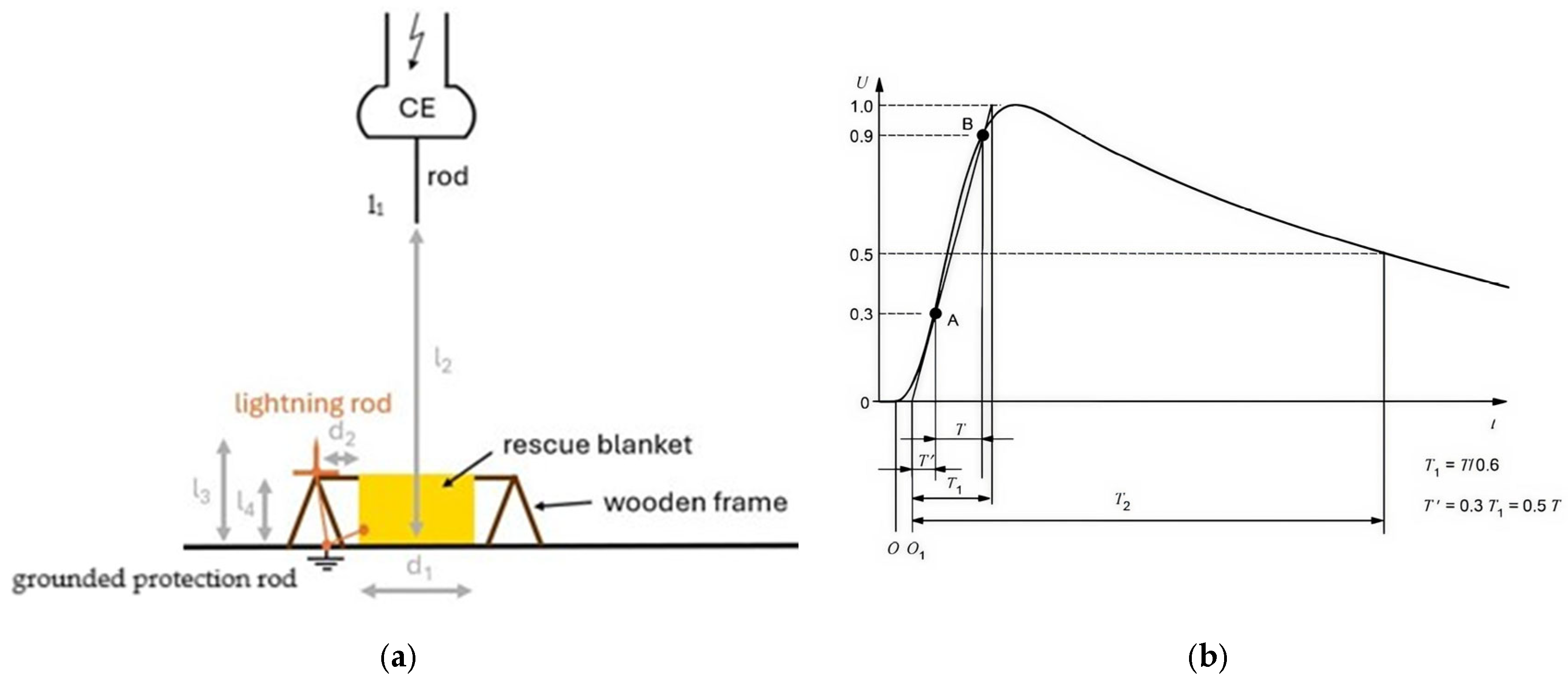
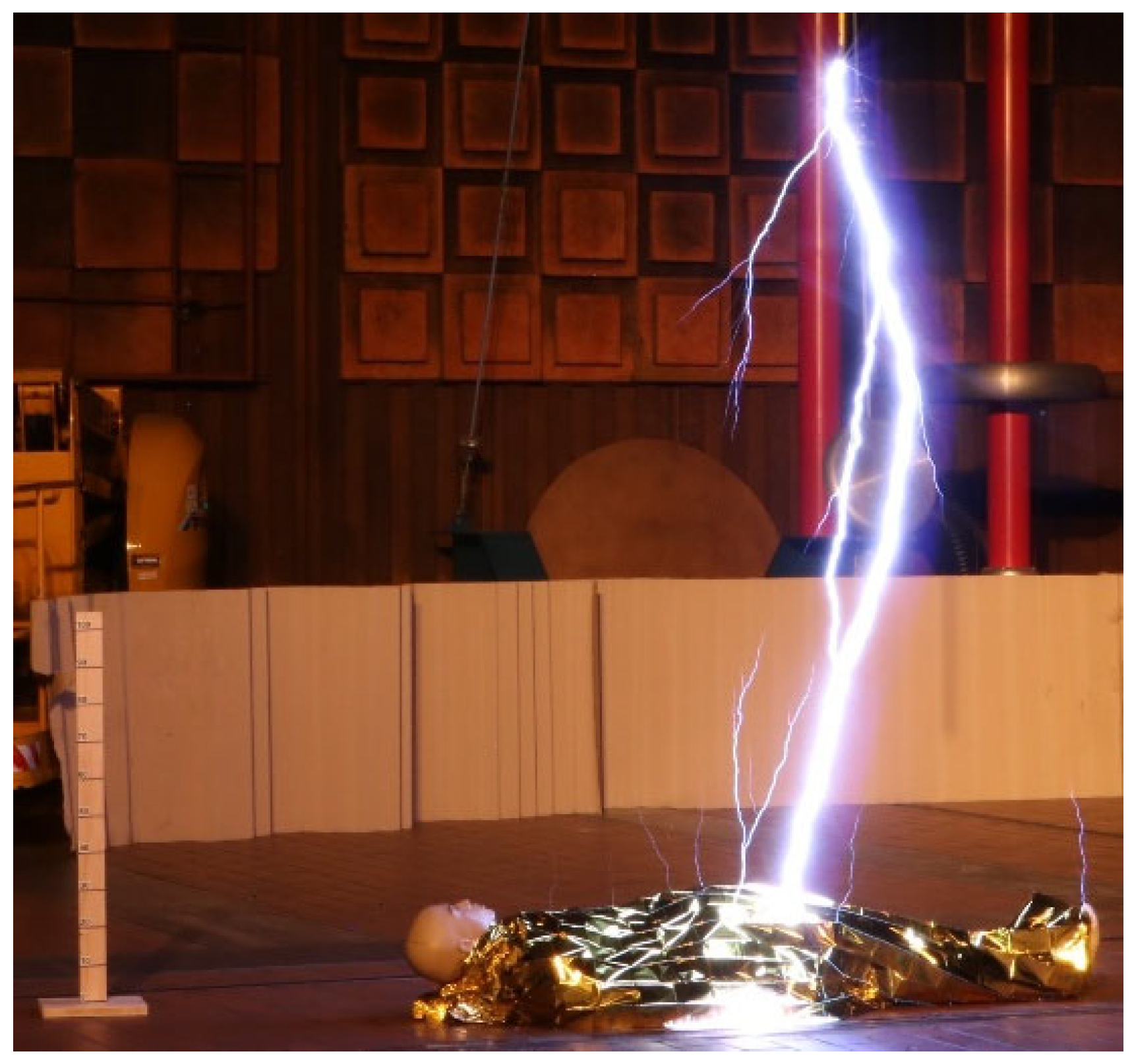
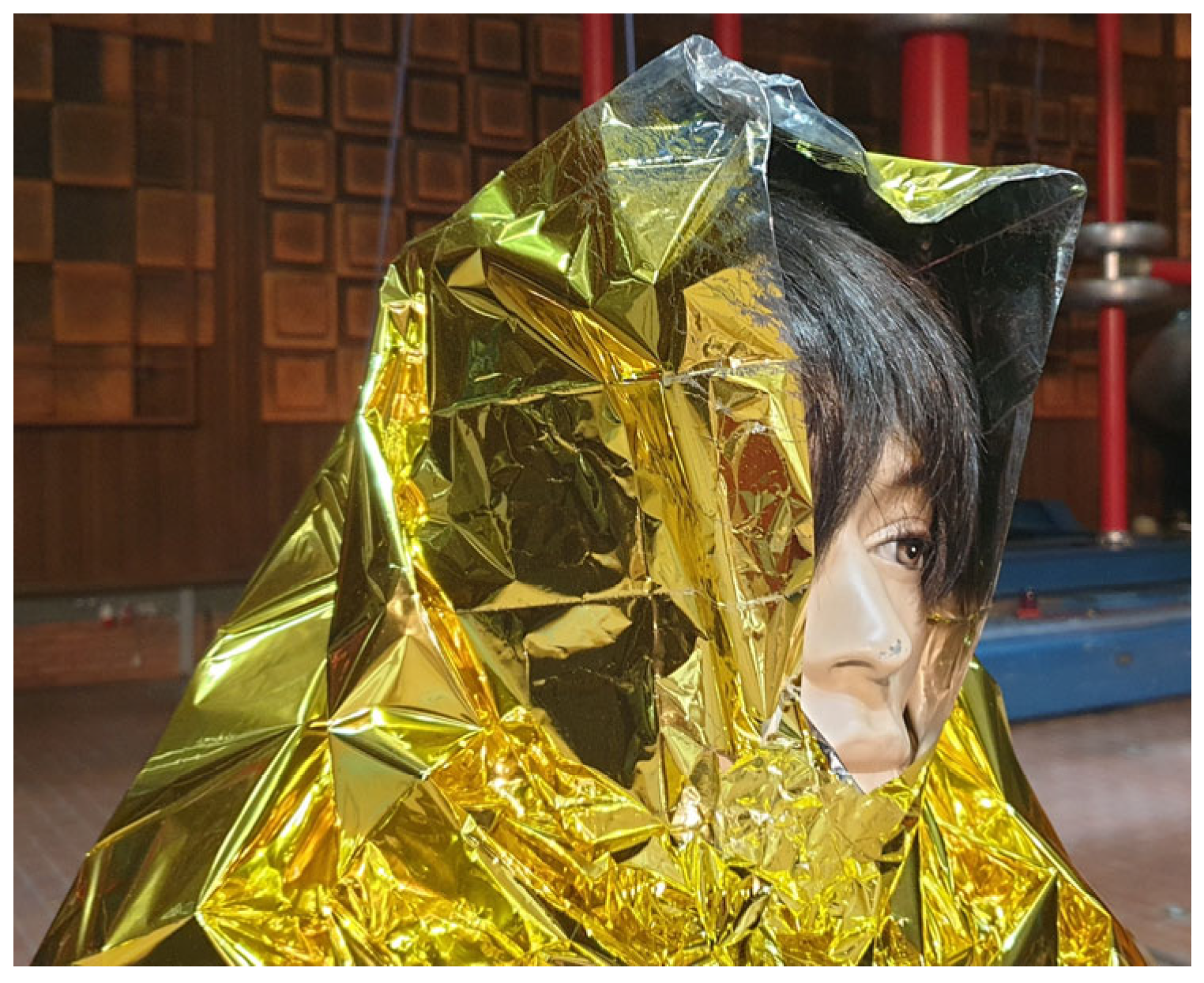
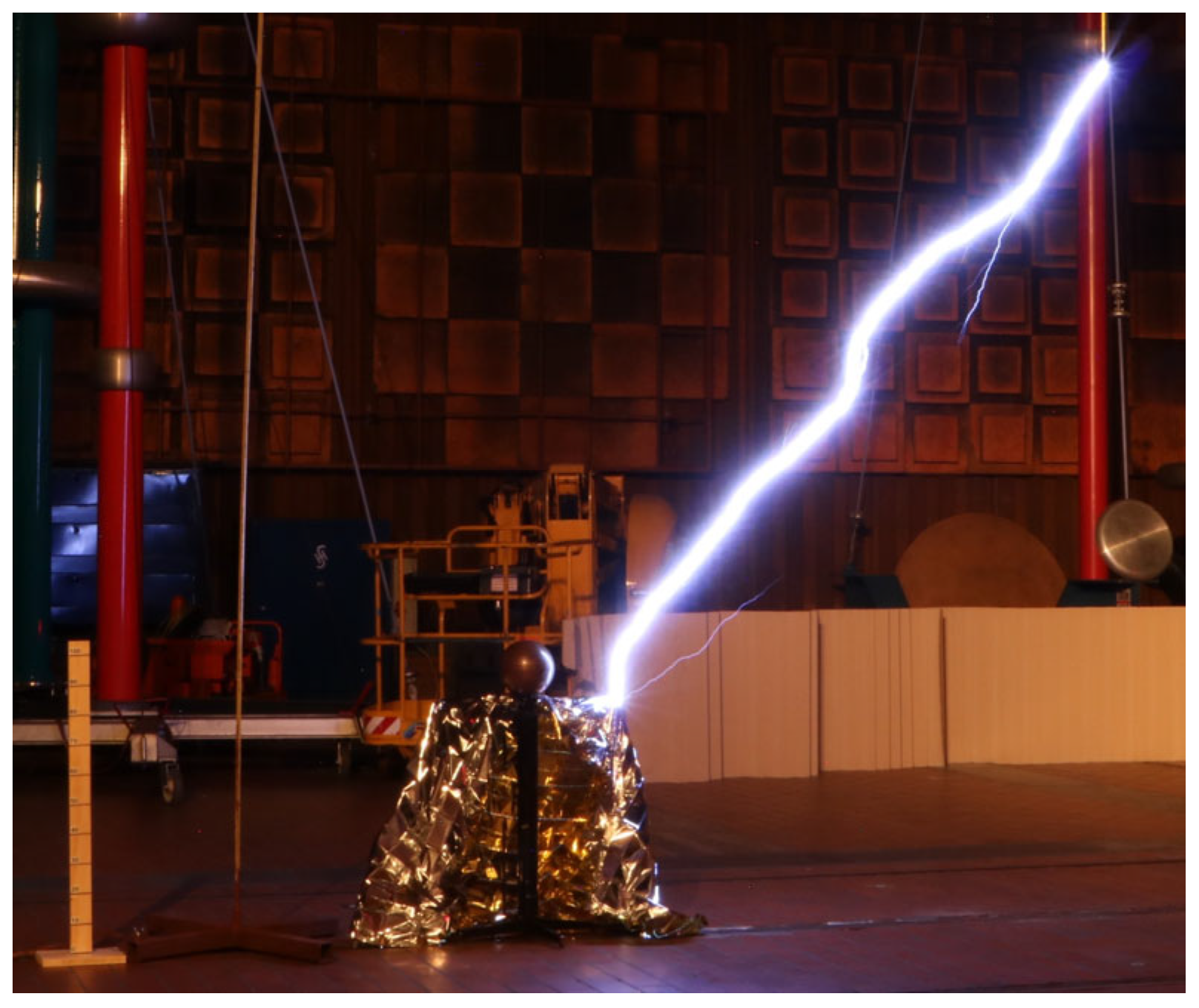
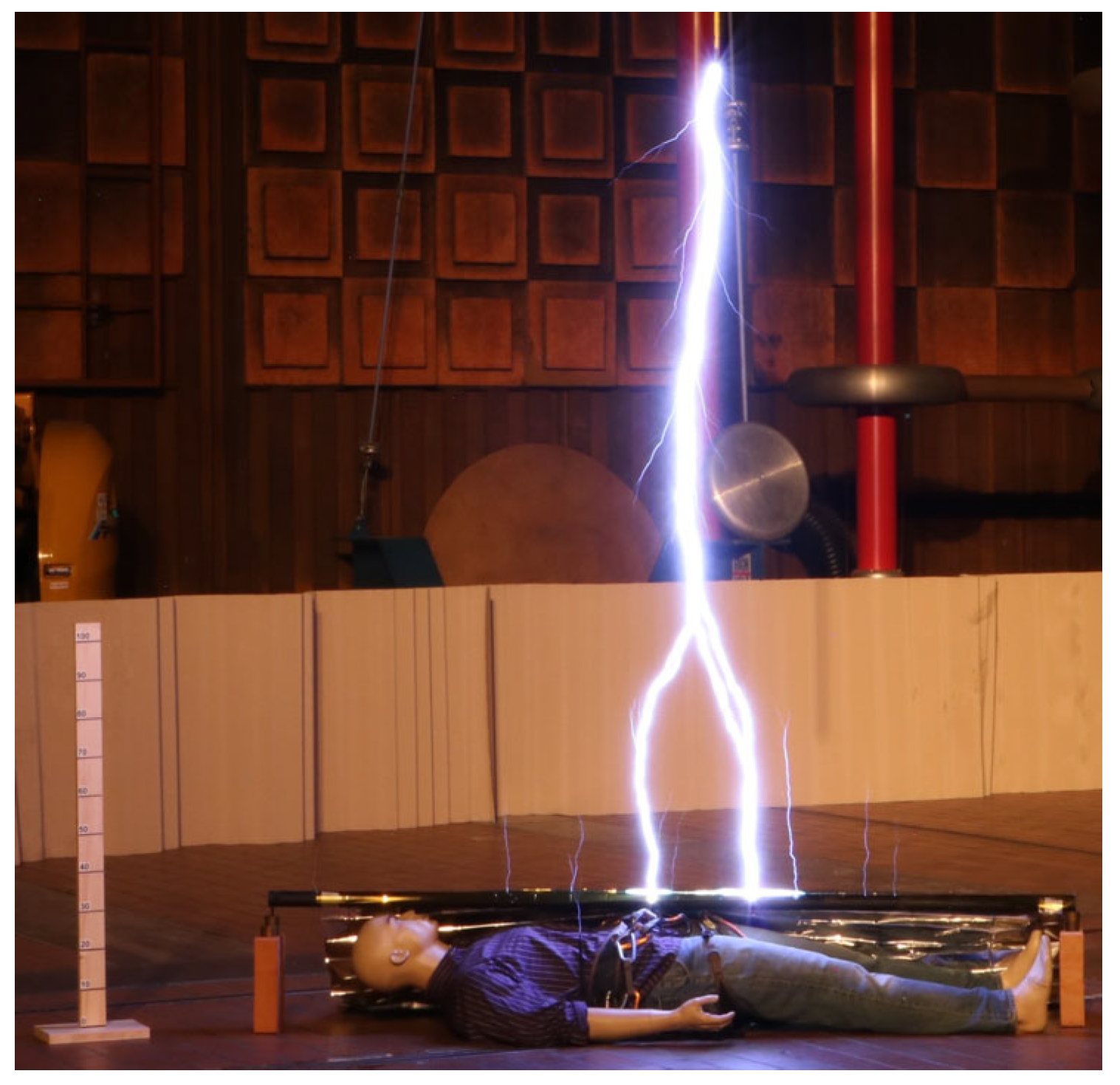
| Section Identification Number (IN) of Upward Leaders Per Test [Length (cm)] | ||||||||
|---|---|---|---|---|---|---|---|---|
| IN-1 | IN-2 | IN-3 | IN-4 | IN-5 | IN-6 | IN-7 | IN-8 | IN-9 |
| Silver/gold—metal surface facing up (n = 38) | ||||||||
| 4 | 6 | 6 | 14 | 10 | 6 | 6 | 7 | 4 |
| 6 | 8 | 10 | 6 | 6 | 6 | 10 | 4 | 4 |
| 4 | 6 | 30 | 12 | 8 | 4 | |||
| 3 | 3 | 3 | 8 | 12 | 32 | 12 | 8 | |
| 6 | 2 | 16 | 18 | 10 | 6 | |||
| Silver/gold—plastic surface facing up (n = 29) | ||||||||
| 4 | 18 | 12 | 14 | 4 | 12 | |||
| 12 | 6 | 6 | 10 | 12 | 6 | 6 | ||
| 10 | 16 | 20 | 24 | 6 | ||||
| 6 | 28 | 6 | 10 | 12 | 4 | |||
| 3 | 46 | 6 | 18 | 4 | ||||
| Silver/silver—metal surface facing up (n = 36) | ||||||||
| 6 | 24 | 12 | 12 | 8 | 4 | 12 | ||
| 3 | 20 | 4 | 10 | 8 | 9 | 6 | ||
| 8 | 6 | 10 | 24 | 4 | 4 | 2 | ||
| 5 | 16 | 5 | 12 | 6 | 6 | 3 | ||
| 4 | 7 | 28 | 8 | 10 | 16 | 6 | 6 | |
| Silver/silver—plastic surface facing up (n = 20) | ||||||||
| 8 | 8 | 12 | 8 | 6 | ||||
| 6 | 4 | 4 | 8 | |||||
| 3 | 16 | 8 | 8 | 8 | 16 | |||
| 8 | 6 | 10 | ||||||
| 4 | 12 | |||||||
| Section Identification Number (IN) of Upward Leaders Per Test [Length (cm)] | ||||||||
|---|---|---|---|---|---|---|---|---|
| IN-1 | IN-2 | IN-3 | IN-4 | IN-5 | IN-6 | IN-7 | IN-8 | IN-9 |
| Silver/gold—metal surface facing up (n = 31) | ||||||||
| 10 | 12 | 3 | 3 | 14 | 16 | 18 | 14 | |
| 4 | 14 | 24 | 4 | 8 | ||||
| 20 | 22 | 22 | 12 | 16 | 18 | 8 | ||
| 20 | 6 | 8 | 16 | |||||
| 6 | 16 | 18 | 1 | 32 | 18 | 20 | ||
| Silver/silver—metal surface facing up (n = 27) | ||||||||
| 4 | 10 | 6 | 20 | 10 | 6 | 4 | ||
| 10 | 18 | 4 | 26 | 10 | 8 | |||
| 8 | 6 | 10 | 8 | 4 | ||||
| 4 | 4 | 24 | 20 | 4 | ||||
| 6 | 6 | 36 | 2 | |||||
Disclaimer/Publisher’s Note: The statements, opinions and data contained in all publications are solely those of the individual author(s) and contributor(s) and not of MDPI and/or the editor(s). MDPI and/or the editor(s) disclaim responsibility for any injury to people or property resulting from any ideas, methods, instructions or products referred to in the content. |
© 2025 by the authors. Licensee MDPI, Basel, Switzerland. This article is an open access article distributed under the terms and conditions of the Creative Commons Attribution (CC BY) license (https://creativecommons.org/licenses/by/4.0/).
Share and Cite
Isser, M.; Lederer, W.; Schwaiger, D.; Maurer, M.; Bauchinger, S.; Pack, S. Rescue Blankets in Direct Exposure to Lightning Strikes—An Experimental Study. Coatings 2025, 15, 868. https://doi.org/10.3390/coatings15080868
Isser M, Lederer W, Schwaiger D, Maurer M, Bauchinger S, Pack S. Rescue Blankets in Direct Exposure to Lightning Strikes—An Experimental Study. Coatings. 2025; 15(8):868. https://doi.org/10.3390/coatings15080868
Chicago/Turabian StyleIsser, Markus, Wolfgang Lederer, Daniel Schwaiger, Mathias Maurer, Sandra Bauchinger, and Stephan Pack. 2025. "Rescue Blankets in Direct Exposure to Lightning Strikes—An Experimental Study" Coatings 15, no. 8: 868. https://doi.org/10.3390/coatings15080868
APA StyleIsser, M., Lederer, W., Schwaiger, D., Maurer, M., Bauchinger, S., & Pack, S. (2025). Rescue Blankets in Direct Exposure to Lightning Strikes—An Experimental Study. Coatings, 15(8), 868. https://doi.org/10.3390/coatings15080868






